

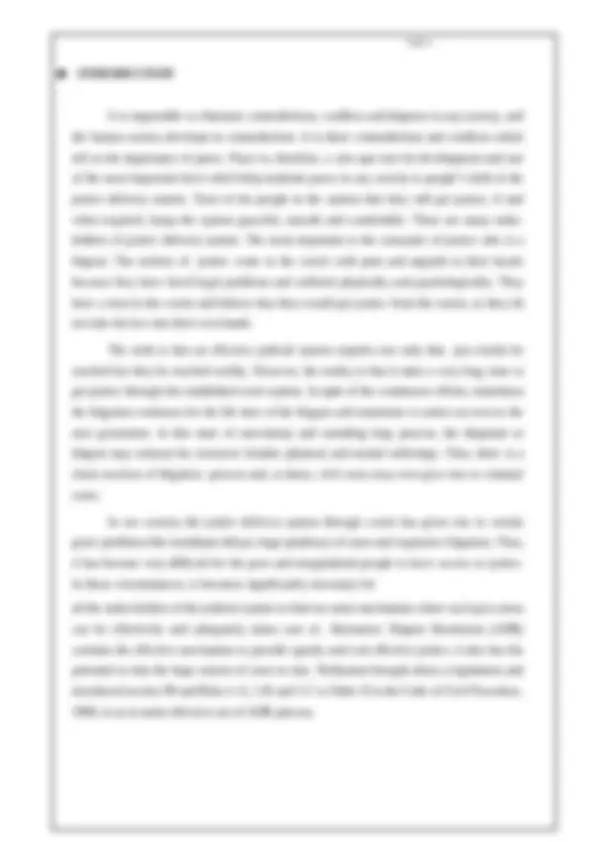





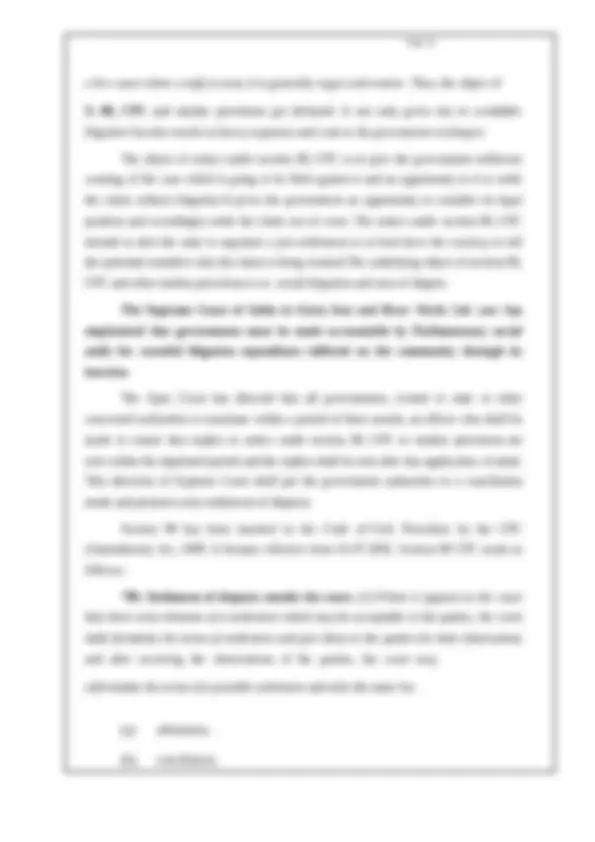
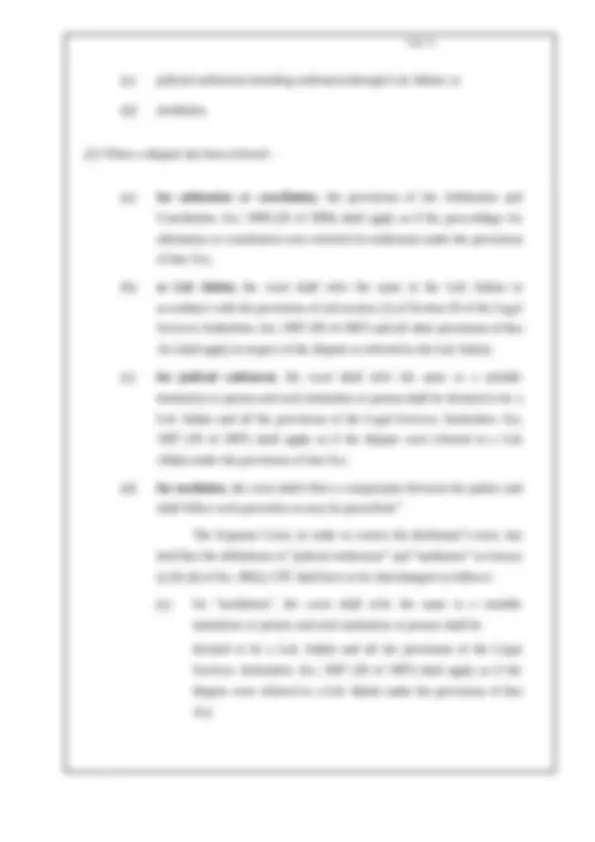
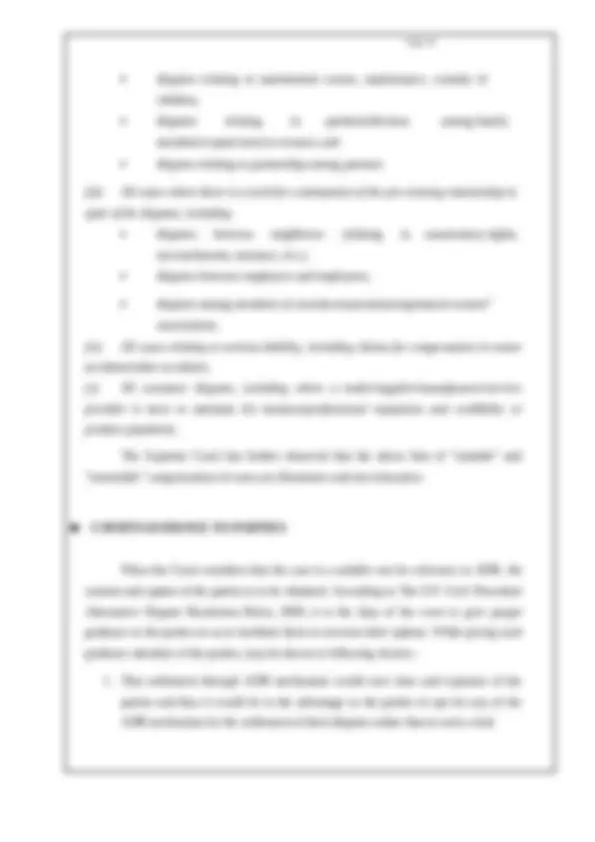
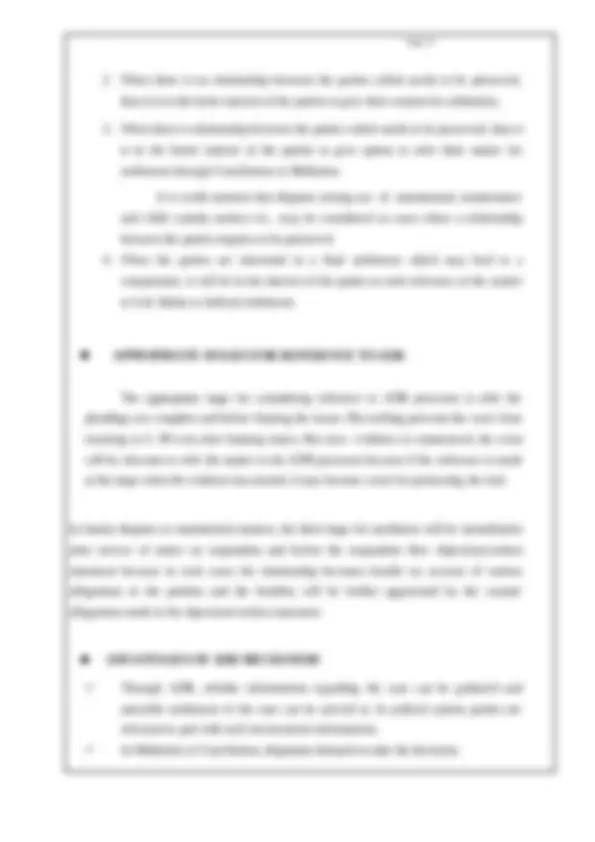





Study with the several resources on Docsity

Earn points by helping other students or get them with a premium plan


Prepare for your exams
Study with the several resources on Docsity

Earn points to download
Earn points by helping other students or get them with a premium plan
Community
Ask the community for help and clear up your study doubts
Discover the best universities in your country according to Docsity users
Free resources
Download our free guides on studying techniques, anxiety management strategies, and thesis advice from Docsity tutors
Describes the Alternate Dispute Resolution practices in a court
Typology: Study Guides, Projects, Research
1 / 22

This page cannot be seen from the preview
Don't miss anything!















Project By:- Shreyas Mahapatra 1782107 BBA LLB ( B)
It is impossible to eliminate contradictions, conflicts and disputes in any society, and the human society develops in contradictions. It is these contradictions and conflicts which tell us the importance of peace. Peace is, therefore, a sine qua non for development and one of the most important facts which help maintain peace in any society is people‟s faith in the justice delivery system. Trust of the people in the system that they will get justice, if and when required, keeps the system peaceful, smooth and comfortable. There are many stake- holders of justice delivery system. The most important is the consumer of justice who is a litigant. The seekers of justice come to the courts with pain and anguish in their hearts because they have faced legal problems and suffered physically and psychologically. They have a trust in the courts and believe that they would get justice from the courts, so they do not take the law into their own hands. The truth is that an effective judicial system requires not only that just results be reached but they be reached swiftly. However, the reality is that it takes a very long time to get justice through the established court system. In spite of the continuous efforts, sometimes the litigation continues for the life time of the litigant and sometimes it carries on even to the next generation. In this state of uncertainty and unending long process, the disputant or litigant may exhaust his resources besides physical and mental sufferings. Thus, there is a chain reaction of litigation process and, at times, civil cases may even give rise to criminal cases. In our country the justice delivery system through courts has given rise to certain grave problems like inordinate delays, huge pendency of cases and expensive litigation. Thus, it has become very difficult for the poor and marginalized people to have access to justice. In these circumstances, it becomes significantly necessary for all the stake-holders of the judicial system to find out some mechanism where such grey areas can be effectively and adequately taken care of. Alternative Dispute Resolution (ADR) contains the effective mechanism to provide speedy and cost effective justice, it also has the potential to trim the huge arrears of cases to size. Parliament brought about a legislation and introduced section 89 and Rules 1-A, 1-B and 1-C to Order X in the Code of Civil Procedure, 1908, so as to make effective use of ADR process.
The history of ADR can be traced to our historical path. The concept of Lok Adalats (People‟s Court) is an innovative contribution of India to the World Jurisprudence. India has a long tradition and history of ADR process like Mediation and Lok Adalat being practiced in the society at the grass root level, these are called Panchayats. The ancient concept of settlement of dispute through Arbitration, Conciliation, Mediation or Negotiation known as the verdict or decision of „Nyaya- Panchayat‟ is conceptualized and institutionalized in the philosophy of Lok Adalat. Concept of mediation has been practiced with great frequency in the last quarter of the 20 th^ Century. After the emergence of 21st^ Century this practice has been developed with more frequency in the Western countries. Its roots can be traced in USA, notably at the Pound Conference in 1976. It was followed by two legislations – The Civil Justice Reforms Act, 1990 and The Administrative Dispute Resolution Act, 1996. There are many Statutes in America which make the mediation mandatory for dispute resolution. The State Bar Associations have set up mediation centers and the American Bar Association has its intensive section for dispute resolution. Other countries like United Kingdom has also introduced mediation system as an alternate for dispute resolution mechanism. In United Kingdom, besides, Civil Procedures Reforms of 1999, Lord Chancellor‟s Department announced in 2001 that all government disputes should be resolved through settlement procedures. Likewise, ADR mechanism was encouraged and implemented in Australia, South Africa and Sri Lanka.
The concept of Lok Adalat for the first time has been introduce in the state of Gujarat in 1982.The main purpose to introduce this concepts was to reduced huge burden which was on the court due to increasing fresh litigation and large numbers of cases pending in the court. Lok Adlat is an appropriate method to resolve the dispute without intervention of court proceeding so that it has been recognized as a statutory body under the legal service authority act, 1987. Legal service Authorities Act, 1987 : The Legal Services Authorities Act, 1987 was brought into force on 19 November 1995.^1 The object of the Act was to provide free and competent legal services to the weaker sections of the society to ensure that opportunities for securing justice are not denied to any citizen. The concept of legal services which includes Lok Adalat is a revolutionary evolution of resolution of disputes. Though settlements were affected by conducting Lok Nyayalayas prior to this Act, the same has not been given any statutory recognition. But under the new Act, a settlement arrived at in the Lok Adalats has been given the force of a decree which can be executed through Court as if it is passed by it. Sections 19, 20, 21 and 22 of the Act deal with Lok Adalat. Section 20 provides for different situations where cases can be referred for consideration of Lok Adalat. Delhi High court has given a landmark decision highlighting the significance of Lok Adalat movement in the case of Abdul Hasan and National Legal Services Authority v. Delhi Vidyut Board and Others****.^2 The court passed the order giving directions for setting up of permanent Lok Adalats. The Apex Court, emphasising the importance of Lok Adalats has observed:- “Lok Adalats have been created to restore access to remedies and protections and alleviate the institutional burden of the millions of petty cases clogging the regular courts. Experience has shown that not only huge numbers of cases are settled through Lok Adalats, this system has definite advantages, some of which are listed below:- (a) speedy justice and saving from the lengthy court procedures; (b) justice at no cost; (c) solving problems of back-log cases, and (d) maintenance of cordial relations.” According to Legal Services Authorities (Amendment) Act 1994 effective from 09- 11-1995 has since been passed, Lok Adalat settlement is no longer a voluntary concept. By this Act Lok Adalat has got statutory character and has been legally recognized. Certain salient features of the Act are enumerated below:- 1 2
Section 19
Judge hosted settlement conference: In this court-based ADR process, the settlement judge (or magistrate) presides over a meeting of the parties in an effort to help them reach a settlement. Judges have played a variety of roles in these conferences, articulating opinions about the merits of the case, facilitating the trading of settlement offers, and sometimes acting as the mediator. Minitrial: A voluntary process in which cases are heard by a panel of high level prinicipals from the disputing sides with full settlement authority; a neutral may or may not oversee this stage. First, parties have a summary hearing, each side presenting the essence of their case. Each party can thereby learn the strengths and weaknesses of their own case, as well as that of other parties. Secondly, the panel of party representatives attempts to resolve the dispute by negotiation. The neutral presider may offer her opinion about the likely outcome in court. Court based minitrial: A similar procedure as that of the above, generally reserved for large disputes, in which a judge, a magistrate and a non-judicial neutral presides over one or two- day hearing. If negotiations fail, the parties proceed to trial. Regulatory Negotiation or Reg-Neg: Used by governmental agencies as an alternative to the more traditional approach of issuing regulations after a lengthy notice and comment period. Instead, “agency officials and affected private parties meet under the guidance of a neutral facilitator to engage in joint negotiation and the drafting of the rule. The public is then asked to comment on the resulting, proposed rule. By encouraging participation of interested stakeholders, the process makes use of private parties’ perspectives and expertise, and can help avoid subsequent litigation over the resulting rule.” Ombudsperson: An informal dispute resolution tool used by organizations. A third party ombudsperson is appointed by the organisation to investigate complaints within the institution and prevent disputes or facilitate their resolution. The Ombudsperson may use various ADR mechanisms in the process of resolving disputes. Private Judging: A private or court-connected process in which the parties empower a private individual to hear and issue a binding, principled decision in their case. The process may be agreed upon by a contract between the parties, or authorized by statute. PROVISIONS RELATING TO ADR
The Arbitration (protocol and convention) act 1937: The Arbitration (protocol and convention) Act 1937 was passed with the intention of giving effect to the protocol and enabling the convention to become operative in India. The Geneva Protocol on Arbitration Clauses 1923 and the Geneva Convention on the Execution of Foreign Arbitral Awards 1927has been implemented in India by the Arbitration (Protocol anConvention) Act, 1937. The Arbitration Act of 1940: During the colonial rule the more definite arbitration act was passed on fourteenth march 1940 which came into effect from first July 1940, named as Arbitration Act 1940. This is only one act which was extended to whole of India including Pakistan and Baluchistan. In the few cases it has been noticed that the arbitration act 1940, distinguish between arbitration an application for setting aside an arbitral award and one for a decision that is a nullity. The Act implies that it does not legally exist aside and contemplates that an application for setting aside an award may be made under the section 30 and an application of that is nullity under section 33. Further it was also observed that the said act fail in recognizing that the arbitration will fail in case of non existence and invalidity of an arbitration agreement. The arbitration act 1940 was not covered to shortcoming which was containing in personal or private contract and the rules providing for awards also differed from one high court to another high court. The lack of provision prohibiting an arbitrator form resigning at any time in the course of the arbitration proceeding exposed the parties to heavy loses particularly where the arbitrator acted with mala fide intention. It was also seen that if an arbitrator appointed by the court dies during the arbitration proceeding, there was no other provision in the said act for appointment of a new arbitrator which was also seen as a major flaw in the act 1940. Arbitration and Conciliation Act, 1996 : This Act, 1996 was based on the UNCITRAL Model Law on International Commercial Arbitration, 1985 and UNCITRAL Conciliation Rules, 1980. General Assembly of the United Nations had recommended that every country should take into consideration to that Model Law in view of non- uniformity of the law of arbitration procedures and particular necessity of the international commercial practices. Also, recommended the practice of the said Rules in those matters where a disagreement arises in the context of international commercial relations and the parties try to find out a friendliness settlement of issue by assistance of conciliation. These rules play an important role for the foundation of a combine legal framework for the just, fair and effective settlement of disputes which arise in international commercial relations. A report was prepared by the law commission of India on the basis of the Act, 1996 and suggested several amendments. Arbitration and Conciliation (Amendment) Bill, 2003 was in the Parliament on the basis of the recommendations of the commission. But the Standing Committee of Law Ministry
inferred that the provisions regarding Alternative Disputes Resolutions are applicable to appellate courts also. Order 23, Rule 3, Code of Civil Procedure mandates the courts to record a full adjustment or compromise and pass a decree in terms of such compromise or adjustment. But the compromise decree has to be recorded as a whole so as to gather the intention of the parties. The court must apply its judicial mind while examining the terms of settlement. The compromise shall not be recorded in a casual manner. The court is under the responsibility to satisfy itself about the lawfulness and genuineness of the compromise. Government of India and State Governments are the largest litigants in India. The government or statutory authorities are defendants in a large number of suits pending in various courts in the country. Section 80, CPC and some other statutes require service of notice as a condition precedent for filing of a suit or other proceedings against the government or authority. It is observed that in a large number of cases where government is a defendant either the required notice is not replied or in
a few cases where a reply is sent, it is generally vague and evasive. Thus, the object of S. 80, CPC and similar provisions get defeated. It not only gives rise to avoidable litigation but also results in heavy expenses and costs to the government exchequer. The object of notice under section 80, CPC is to give the government sufficient warning of the case which is going to be filed against it and an opportunity to it to settle the claim without litigation.It gives the government an opportunity to consider its legal position and accordingly settle the claim out of court. The notice under section 80, CPC intends to alert the state to negotiate a just settlement or at least have the courtesy to tell the potential outsiders why the claim is being resisted.The underlying object of section 80, CPC and other similar provisions is to curtail litigation and area of dispute. The Supreme Court of India in Geeta Iron and Brass Works Ltd. case has emphasised that governments must be made accountable by Parliamentary social audit for wasteful litigation expenditure inflicted on the community through its inaction. The Apex Court has directed that all governments, central or state or other concerned authorities to nominate within a period of three month, an officer who shall be made to ensure that replies to notice under section 80, CPC or similar provisions are sent within the stipulated period and the replies shall be sent after due application of mind. This direction of Supreme Court shall put the government authorities in a conciliation mode and promote early settlement of disputes. Section 89 has been inserted in the Code of Civil Procedure by the CPC (Amendment) Act, 1999. It became effective from 01.07.2002. Section 89 CPC reads as follows:- “89. Settlement of disputes outside the court.- (1) Where it appears to the court that there exist elements of a settlement which may be acceptable to the parties, the court shall formulate the terms of settlement and give them to the parties for their observations and after receiving the observations of the parties, the court may reformulate the terms of a possible settlement and refer the same for-
between the parties and shall follow such procedure as may be prescribed. Order 10 Rule 1-A: “1-A. Direction of the court to opt for any one mode of alternative dispute resolution.- After recording the admissions and denials, the court shall direct the parties to the suit to opt either mode of the settlement outside the court as specified in sub-section (1) of Section 89. On the option of the parties, the court shall fix the date of appearance before such forum or authority as may be opted by the parties.” Order 10 Rule 1-B: “ 1-B. Appearance before the conciliatory forum or authority.- Where a suit is referred under Rule 1-A, the parties shall appear before such forum or authority for conciliation of the suit.” Order 10 Rule 1-C: “1-C. Appearance before the court consequent to the failure of efforts of conciliation .- Where a suit is referred under Rule 1-A and the presiding officer of conciliation forum or authority is satisfied that it would not be proper in the interest of justice to proceed with the matter further, then, it shall refer the matter again to the court and direct the parties to appear before the court on the date fixed by it.” Section 89, CPC confers the jurisdiction on the court to refer a dispute to an ADR process whereas Rules 1-A to 1-C of Order X lays down the manner in which the jurisdiction is to be exercised by the Court. The scheme is that the court explains the choices available regarding ADR process to the parties, permit them to opt for a process by consensus, and if there is no consensus, proceeds to choose the process. CASES “ UNSUITABLE ” & “ SUITABLE ” for ADR PROCESSES
Supreme Court of India has observed that the following categories of cases, having regard to their nature, are normally considered to be not suitable or suitable for ADR Processes :- Cases “unsuitable” for ADR Processes (Excluded category of cases)
groups regarding management of Societies, Clubs, Association etc.)
grant of probate or letter of administration.
forgery, impersonation, coercion, etc.
mentally challenged and suits for declaration of title against the Government.
Cases “suitable” for ADR Processes Except the excluded category of cases (as mentioned above), all other suits and cases of civil matters in particular, the following cases are normally considered to be suitable for A.D.R. processes: (i) All cases relating to trade, commerce and contracts (including all money cases)
(ii) All cases arising from strained or soured relationships, including
than it is in the better interest of the parties to give their consent for arbitration.
is in the better interest of the parties to give option to refer their matter for settlement through Conciliation or Mediation. It is worth mention that disputes arising out of matrimonial, maintenance and child custody matters etc., may be considered as cases where a relationship between the parties requires to be preserved.
compromise, it will be in the interest of the parties to seek reference of the matter to Lok Adalat or Judicial settlement. APPROPRIATE STAGES FOR REFERENCE TO ADR The appropriate stage for considering reference to ADR processes is after the pleadings are complete and before framing the issues. But nothing prevents the court from resorting to S. 89 even after framing issues. But once evidence is commenced, the court will be reluctant to refer the matter to the ADR processes because if the reference is made at the stage when the evidence has started, it may become a tool for protracting the trial. In family disputes or matrimonial matters, the ideal stage for mediation will be immediately after service of notice on respondent and before the respondent files objections/written statement because in such cases the relationship becomes hostile on account of various allegations in the petition and the hostility will be further aggravated by the counter allegations made in the objections/written statement. ADVANTAGES OF ADR MECHANISM Through ADR, reliable informations regarding the case can be gathered and amicable settlement of the case can be arrived at. In judicial system parties are reluctant to part with such inconvenient informations. In Mediation or Conciliation, disputants themselves take the decisions.
There are lesser formalities in ADR than the traditional judicial system. Settlement through ADR Process is cost effective and less time consuming. ADR system brings about a win-win situation for the parties whereas in the court procedure there is a win-lose situation. Through ADR system the result is final. Advantages of Mediation. Mediation is participative and the parties directly participate in the negotiation. Parties have control over the mediation. They have the right to decide whether or not to settle the dispute and the terms of settlement. The procedure of mediation is speedy, efficient and cost-effective. The process is conducted in an informal, cordial and conducive environment. Mediation is a confidential process. Mediation process facilitates better and effective communication between the parties. Mediation helps to maintain, improve and restore relationships between the parties. Mediation process is voluntary because the parties are at liberty to opt out of it at any stage. If any party feels that the mediation process is not helping him, he can opt out of it. Mutually beneficial settlement is reached out in mediation. The process of mediation always considers the long term and underlying interests of the parties at each stage of the dispute resolution process. In the case of settlement in court referred mediation, refund of court fees is permitted as per rules.